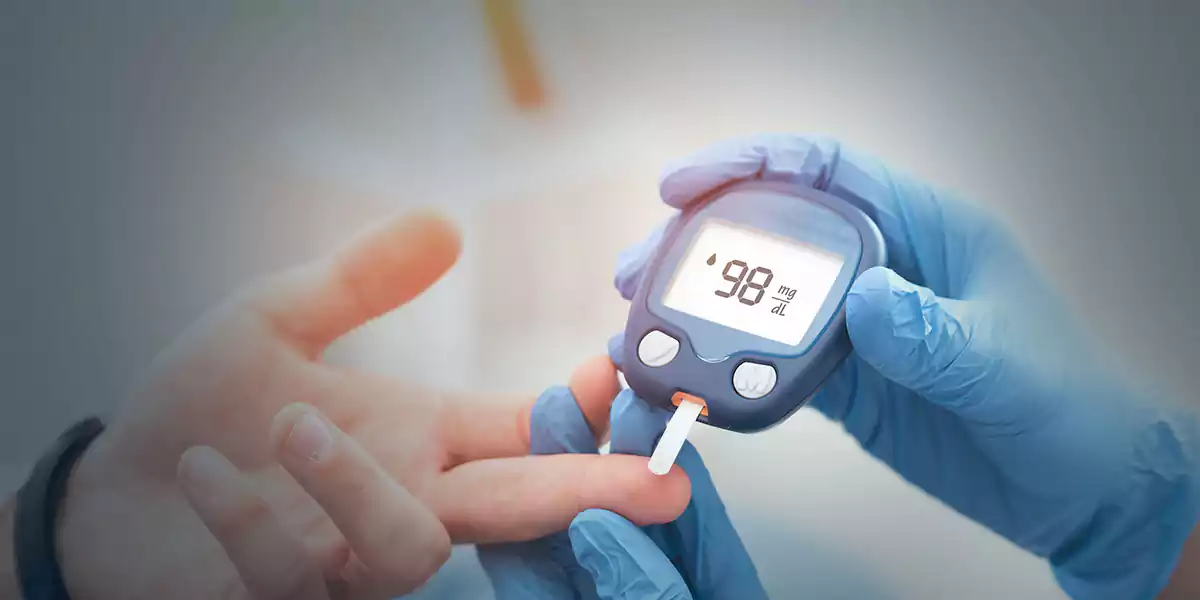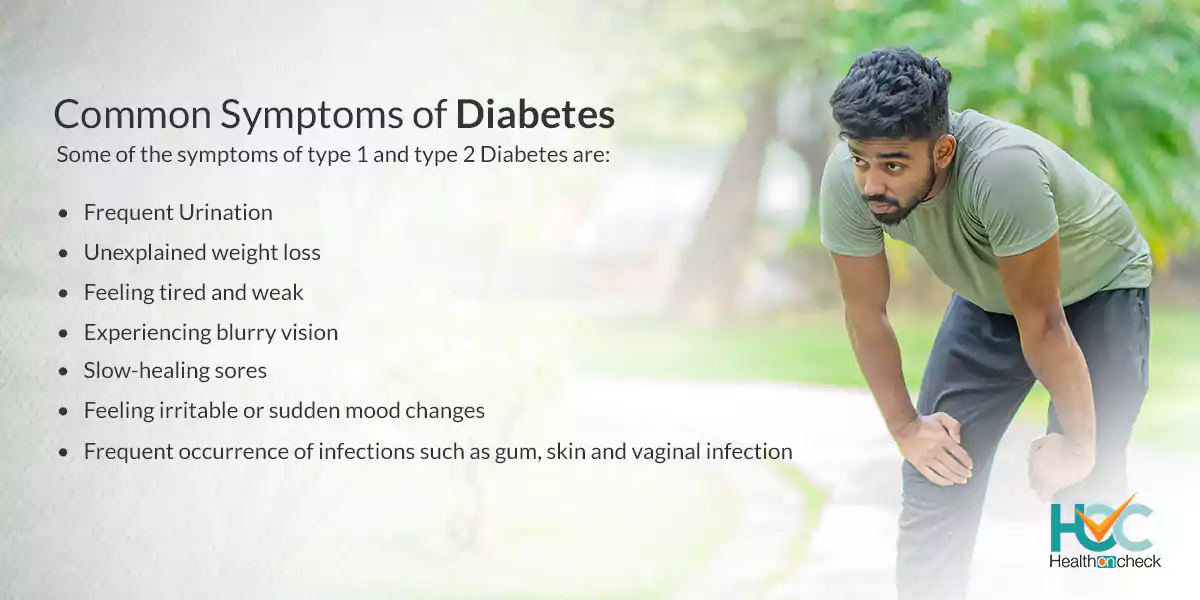All about Diabetes

What is Diabetes?
Diabetes is a chronic condition resulting in high blood sugar or glucose in the blood. The hormone insulin moves the sugar from the bloodstream into your cells to be used for energy. With Diabetes, the body either doesn’t make the necessary insulin or cannot effectively use it even if it makes it.
Untreated & undetected high blood sugar levels can damage your nerves and multiple organs, including kidneys, eyes etc. Therefore, awareness about Diabetes and taking the necessary steps to manage it is necessary and can help you protect your health in the long run.
What are the main types of Diabetes?
The following are the most common types of Diabetes:
Type 1 Diabetes
Type 1 is an autoimmune disease. In this, the immune system attacks and destroys the pancreas, for which it cannot produce enough insulin.
Type 2 Diabetes
Type 2 happens when the body becomes insulin resistant, and sugar builds up in the bloodstream. It’s the most common type of Diabetes that strikes most people.
Gestational Diabetes
Gestational Diabetes occurs in pregnancy which causes a rise in blood sugar levels in the body. Insulin-blocking hormones, which are produced by the placenta, are the main cause of this type of Diabetes. Experts believe that gestational Diabetes many times put one at a higher risk of developing Type 2 Diabetes in future or after pregnancy.
What are the common symptoms of Diabetes?
The symptoms of Diabetes generally depend upon how high your blood sugar levels. People suffering from type 2 Diabetes may not even display certain symptoms. In type 1 Diabetes, symptoms come early and can be more severe in nature.

Some of the symptoms of type 1 and type 2 Diabetes are:
- Feeling thirstier than usual.
- Frequent Urination
- Unexplained weight loss
- The presence of ketones in the urine stream. Ketones are the byproduct of the breakdown of muscle and fat. It generally occurs when there’s not enough available insulin
- Feeling tired and weak
- Feeling irritable or sudden mood changes
- Experiencing blurry vision
- Slow-healing sores
- Frequent occurrence of infections such as gum, skin and vaginal infection
What are the common causes of Diabetes?
The main cause of Diabetes, irrespective of the type, is excessive glucose circulating or building up in the bloodstream. However, the reason why blood glucose levels are high can depend upon the type of Diabetes and may be caused by genetic or environmental factors.
Causes of Type 1 Diabetes:
Insulin-producing cells in the pancreas are attacked and destroyed by the body as a result of an immune system disorder. Glucose builds up in circulation without insulin, which allows glucose to enter your cells. Some patients may also be affected by their genes. A virus could also set off an immune system attack.
Causes of Type 2 Diabetes and Prediabetes
The cells in the body prevent insulin from working as it should let glucose into the cells. The cells in your body are no longer susceptible to insulin. Your pancreas cannot keep up with producing enough insulin needed for this resistance. Consequently, the amount of glucose in your blood increases.
Causes of Gestational Diabetes
Hormones produced by the placenta during pregnancy make the body’s cells more resistant to insulin. The pancreas can’t produce enough insulin to resist this. A high amount of glucose builds up in your bloodstream.
What are the main risk factors for Diabetes?
The risk factors for Diabetes depend on the type of Diabetes. One’s family history may play a big part in all types of Diabetes. For type 1 Diabetes, environmental factors and geography can play as risk factors.
Sometimes family members of a type 1 diabetic are tested for the presence of autoantibodies, which is Diabetes immune system cells. If one has these cells, then there is a higher risk of developing type 1 Diabetes. But not everyone who has autoantibodies can develop Diabetes.
How would I know if I am diabetic?
The following tests will help you to diagnose Diabetes:
- A fasting plasma glucose test measures your blood glucose after you have a fast of 8 hours. This test is used primarily to detect Diabetes and prediabetes.
- An oral glucose tolerance test measures your body’s blood sugar after 8 hours of your meal and 2 hours after you drink a glucose-containing beverage. This test is used for diagnosing Diabetes or prediabetes.
- A random plasma glucose test, where your doctor checks your blood glucose and doesn’t follow the 8 hours fasting rule. This test, along with an evaluation of symptoms, is used to diagnose only Diabetes, but it doesn’t diagnose prediabetes.
- A haemoglobin A1c (HbA1c) test can be done without 8 hours of fasting and used to diagnose both prediabetes and Diabetes.
Treatment: How to Treat Diabetes?
Diabetes can lead to serious health problems, so you shouldn’t treat it on your own. Always visit a doctor who will help you to make a proper treatment plan that is right for your condition. Try to get in touch with a Diabetes specialist (endocrinologist).
Also, once you are diagnosed with Diabetes, you need to keep an eye on your blood sugar levels and maintain the proper diet, exercise, and medications that you have been provided with by your health expert. Besides, you should continue to exercise and pay attention to your food habit to avoid rapidly changing blood sugar levels, followed by medication dosages.
What are the Complications of having Diabetes for a longer time?
If your blood glucose level remains increased over a long period of time, it has a higher chance of damaging your multi organs or body tissues. Some complications, if not getting attention at the right time, can be life-threatening.
Complications can be:
- Cardiovascular issues like coronary artery disease, heart attack, chest pain, stroke, high blood pressure and atherosclerosis (narrowing of arteries), etc.
- Eye damage or retinopathy that can lead to blindness; or severe conditions like cataracts or glaucoma
- Nephropathy or Kidney damage is a very common complication in long-term diabetic patients, which can eventually lead to kidney failure or in a condition where dialysis and kidney transplant are necessary
- Neuropathy-like nerve-damaging disease which can cause numbing and tingling that starts at the toes or fingers and then spreads.
- Foot damage or nerve damage, also poor blood flow which, reduces the healing ability of cuts
- Erectile dysfunction
- Hearing problems
- Dental or gum-related problems
- Several Skin infections.
- Dementia
- Depression
Complications of gestational diabetic patients:
In the mother: conditions like Preeclampsia (high blood pressure, excess protein in the urine, and leg/feet swelling) can be developed. Gestational Diabetes includes the risk of developing Diabetes later in life.
In the newborn: low blood sugar (hypoglycemia), Higher-than-normal birth weight, higher risk of developing Type 2 Diabetes in future and death shortly after birth.
Living with Diabetes
You will need to take a few steps to keep your risk factors under control and within the normal range, including:
- Always keep an eye on your blood glucose level and try to keep it in the normal range by following a proper diet chart, taking medicines on time and doing some physical activity.
- Maintaining your heart health and keeping cholesterol and triglyceride levels in a normal range
- Controlling blood pressure is necessary. It should not exceed the normal range.
You can control your Diabetes by managing lifestyles choices:
- Eat food according to your health expert’s suggestion. Vegetables, fruits, beans, and whole grains should be added to your diet. Foods that are high in fibre and nutrition and low in calories and fat should be consumed more
- Try to do some basic exercise regularly
- Taking medication and insulin on time
- Monitoring the blood sugar level and blood pressure level regularly
- Quit smoking and drinking




